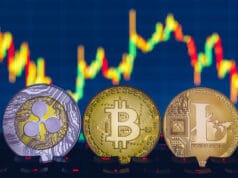Over the past several years, cryptocurrencies have been staging volatile price moves that have made and broken many an investor’s careers. News of traders making millions practically overnight has spearheaded their widespread adoption. Every investor, individual or institutional, is looking to benefit from such significant rallies. However, what causes these price swings? Seeing as cryptocurrencies are intangible, virtual assets, how can they be worth as much as they are? Before we dive into this, let’s look at how fiat currency gains value.
The value of fiat in focus
If we’re getting down to brass tacks, fiat, or any other currency, really, it only holds value because people are in consensus that it does. Think about it, the paper on which the $100 bill is printed is nearly worthless. So is that of a 20 euro bill. Initially, the US dollar was backed by gold, which dictated its value. When that backing was dropped, people just agreed that a piece of paper with the face of a dead president could be traded for a specific amount of goods and services.
Fiat currencies are mainly controlled by central banks and, by extension, the government. These banks can print as much of this money as they wish, which could result in inflation. What’s more, if the central bank or government is rendered incapable of backing their own currency, such currencies tend to crash.
The supply and demand of fiat also play a role in its valuation. For instance, if foreign governments hold USD reserves, it reduces the greenback’s supply and raises its value. If, for some reason, these governments all cashed in these reserves, the dollar’s value would plummet.
Factors that contribute to a cryptocurrency’s value
Supply and demand
Much like their fiat counterparts, crypto derives its value from its supply and demand. As a matter of fact, any tradable commodity’s valuation is dependent on the relationship between its supply and demand. If demand goes up faster than supply, then the commodity’s price goes up. If demand falls relative to supply, so does its price.
Some cryptocurrencies, such as BTC, have a fixed supply. Hence, their value cannot be brought down by inflationary pressures. Others, like ETH, have no maximum supply but have mechanisms to ensure a fixed increase in supply. Other tokens execute regular burns to control the supply of coins in circulation.
Demand for crypto can increase when a project has increased utility or enjoys widespread hype. Popular DeFi projects, for instance, have led to a spike in their native tokens. This has been positive for ETH as well, as Ethereum is the most popular host platform for such projects.
Competition
In the early 2010s, Bitcoin took the lion’s share of the entire crypto market’s market cap due to the lack of competition. Nowadays, there are more than 18,000 cryptocurrencies, and Bitcoin’s dominance stands at a little over 40%. Though Bitcoin has managed to maintain its value despite the numerous new entrants, this shows the level of competition in the market.
Investors will likely flock to the new project if a new coin builds a network that greatly improves an existing one, increasing its value. At the moment, there are several Ethereum killers looking to capitalize on the network’s shortcomings, all in a bid to take over a portion of its market share. In the meme world, several coins are looking to overtake Dogecoin as the king of meme coins.
Influence of celebrities
Over the years, we’ve witnessed cryptocurrencies making massive gains due to a celebrity’s endorsement. Elon Musk, Tesla and SpaceX CEO, is one good example of this. In 2020, he took to Twitter and wrote, “One word: Doge.” The cryptocurrency he was endorsing, Dogecoin, rallied 20% after that tweet. Two months later, he posted another endorsing tweet which saw it spike by 40%. Another two months later, the eccentric billionaire was at it again, and this time Doge doubled in price.
Regulations and policies
Since crypto is still a nascent space, the issue of regulation has largely been up for debate. The SEC is of the opinion that crypto is like securities and should thus be their purview. The CFTC claims that these digital assets are commodities like any other, and so should be regulated by them. A ruling is yet to be made favoring one or the other.
Regulations can facilitate the easier trading of cryptocurrencies. For instance, crypto ETFs and futures can provide access to these digital assets for institutional investors and regulated funds. The same regulations could also negatively impact a cryptocurrency’s price. If a statutory body bans a cryptocurrency, it could lower its price following the reduced demand.
Whales
In crypto, a whale is any address that holds more than 1% of a coin’s total circulating supply. Usually, when these addresses make large orders, they are capable of moving the markets depending on the direction of their trades. For instance, a whale buying large quantities of a cryptocurrency may cause price spikes, as bidders raise their prices with the increased demand. Other investors, out of FOMO, then buy into the coin, which drives its price higher. This is how whales cause an artificial price surge. This is especially prevalent in low-cap cryptocurrencies.
In a nutshell
Cryptocurrencies are digital, intangible assets used as a trustless medium of exchange. They gain their value primarily because of the consensus by the majority that they have value. This is also the case with fiat currencies. A crypto’s demand and supply, its utility and hype, and any regulatory pressures and action by whales are some of the factors that determine its value. Competition, as well as endorsement from celebrities, can also influence the valuation of such a token.




